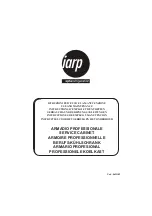
EN - 31
4 FOOD STORAGE
4.1 Refrigerator Compartment
•
To reduce humidity and avoid the
consequent formation of frost, always
store liquids in sealed containers in the
refrigerator. Frost tends to concentrate in
the coldest parts of the evaporating liquid
and, in time, your appliance will require
more frequent defrosting.
•
Never place warm food in the
refrigerator. Warm food should be
allowed to cool at room temperature
and should be arranged to ensure
adequate air circulation in the refrigerator
compartment.
•
Make sure no items are in direct contact
with the rear wall of the appliance as
frost will develop and packaging will stick
to it. Do not open the refrigerator door
frequently.
• We recommend that meat and clean fish
are loosely wrapped and stored on the
glass shelf just above the vegetable bin
where the air is cooler, as this provides
the best storage conditions.
•
Store loose fruit and vegetable items in
the crisper containers.
•
Store loose fruit and vegetables in the
crisper.
•
Storing fruit and vegetables separately
helps prevent ethylene-sensitive
vegetables (green leaves, broccoli,
carrot, etc.) being affected by ethylene-
releaser fruits (banana, peach, apricot,
fig etc.).
•
Do not put wet vegetables into the
refrigerator.
•
Storage time for all food products
depends on the initial quality of the food
and an uninterrupted refrigeration cycle
before refrigerator storage.
•
To avoid cross-contamination do not
store meat products with fruit and
vegetables. Water leaking from meat
may contaminate other products in the
refrigerator. You should package meat
products and clean any leakages on the
shelves.
• Do not put food in front of the air flow
passage.
•
Consume packaged foods before the
recommended expiry date.
NOTE
: Potatoes, onions and garlic
should not be stored in the refrigerator.
The table below is a quick guide to show
you the most efficient way to store the
major food groups in your refrigerator
compartment.
Food
Maximum
storage time
How and where to
store
Vegetables
and fruits
1 week
Vegetable bin
Meat and
fish
2 - 3 Days
Wrap in plastic foil,
bags, or in a meat
container and store
on the glass shelf
Fresh
cheese
3 - 4 Days
On the designated
door shelf
Butter and
margarine
1 week
On the designated
door shelf
Bottled
products
e.g. milk
and
yoghurt
Until the
expiry date
recommended
by the
producer
On the designated
door shelf
Eggs
1 month
On the designated
egg shelf
Cooked
food
All shelves
4.2 Freezer Compartment
•
The freezer is used for storing frozen
food, freezing fresh food, and making ice
cubes.
•
For freezing fresh food; wrap and seal
fresh food properly, that is the packaging
should be air tight and shouldn’t leak.
Special freezer bags, aluminum foil
polythene bags and plastic containers
are ideal.
• Do not store fresh food next to frozen
food as it can thaw the frozen food.
•
Before freezing fresh food, divide it into
portions that can be consumed in one
sitting.
Содержание FFR32GFELT
Страница 1: ...User Manual Fridge Freezer FFR32GFELT FFR32GFERT FFR32GFEMT ...
Страница 2: ......
Страница 39: ...EN 38 ...
Страница 40: ...User Manual Fridge Freezer FFR32GFELT FFR32GFERT FFR32GFEMT 52273481 ...









































